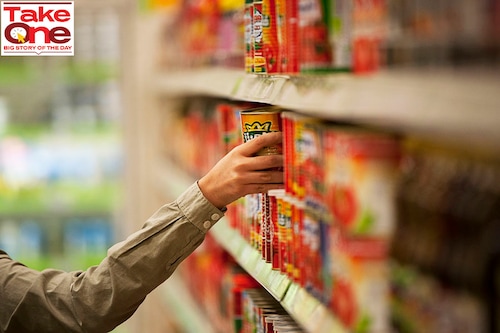Makers of tomato purees are keeping up with the skyrocketing demand. For now
As the tomato crisis hits home restaurants and households have been switching to alternatives like tomato puree and tomato paste. But will the stocks of the latter hold up?


Late on Thursday evening, as the manager at Matunga’s popular Classic restaurant watches over waiters serving platefuls of pav bhaji garnished with a blob of butter to seated customers, he admits business has been tough. The rise in prices of tomatoes has affected them but they haven’t increased prices on their menu. It’s raining lightly and a delightful breeze blows through the part-open restaurant with a makeshift roof for the monsoons.
Classic continues to use fresh tomatoes in its dishes, he says, sourced from Mumbai’s wholesale market in Vashi where prices hit Rs 150 per kilo, up from Rs 30 per kilo a few weeks ago. In the retail markets of Mumbai and Delhi tomatoes were being sold for Rs 160 to Rs 180 per kilo until last week. Currently prices are hovering at Rs 120 to Rs 130 per kilo, still up almost 70 percent from the usual Rs 40 per kilo price as India is gripped by a nationwide shortage of tomatoes. The shortage has been attributed to high, unseasonal rainfall in recent months which devasted the growing tomato crops and fuelled a deadly fungal disease.
As a result, most restaurants—unlike Classic—are swapping out fresh tomatoes for tomato puree or tomato paste. A 200ml packet of it, roughly equivalent to about 450gm of fresh tomatoes, is available for Rs 25 to Rs 27.
At VK Stores, a decade-old establishment in Mumbai’s bustling Crawford Market, proprietor Jenil Dedhia, who deals only in bulk items, has seen demand for 800ml packages of Austin-brand tomato puree shoot up from two per week to seven to eight per week. “We mostly cater to restaurants and hotels. Those who make items like pav bhaji, pasta etc. are using purees and pastes now. Everyone is feeling the pinch," he says.
For the next couple of months Dedhia has enough stock to cater to the rise in demand from his customers. Thereafter, he’s hoping tomato prices will normalise. “Let’s see," he says with a shrug, sounding more hopeful than certain.
Interestingly, the large, organised Horeca players, that is hotels, restaurants, and caterers, are largely insulated from the skyrocketing tomato prices. That’s because they lock in the prices of vegetables and fresh produce at an annual rate, explains Varun Khera, a Delhi-based restauranteur and Noida chapter head of the National Restaurant Association of India. The practice began almost 12 years ago when the prices of onions, a staple in Indian cooking, rose from around Rs 35 per kilo to around Rs 85 per kilo in a period of one week following excessive, unseasonal rainfall in India’s onion-producing regions.
“Since then it has been standardised practice for the bigger players to lock in the prices of vegetables at an annual rate. So presently, it’s the smaller players who procure vegetables at daily or monthly rate who are struggling," says Khera. They’re coping by switching to tomato puree and readymade gravies rather than pass on the cost to customers. “You can’t keep changing the prices on your menu. Besides things should normalise in a month or so," he says.
Households too are feeling the pinch. A middle-aged lady at Classic restaurant waiting on her pav bhaji, says she’s started using Dabur’s Homemade tomato puree brand instead of fresh tomatoes. “We use tomatoes in all our dishes. It’s just too costly now," she says.
Sales of tomato puree have surged on platforms like Amazon Fresh. “We have witnessed a 5x and 1.3x rise in demand for tomato purée and tomato ketchup, respectively on Amazon Fresh over the past few weeks. This could be due to the recent increase in tomato prices nationwide," says Srikant Sree Ram, Director, Amazon Fresh.
Speedy delivery platform Zepto too is seeing a surge in sales of tomato alternatives. Tomato puree sales are 120 percent higher compared to the first week of June, while ketchup sales are 20 percent higher, says Saurabh Maheshwari, senior vice president, category and buying, Zepto.
So how are the makers of tomato purees keeping up with the skyrocketing demand?
Zihwa Foods, a Tamil Nadu-based maker tomato puree and other canned foods which goes by the brand name Topps, has seen a surge in tomato puree sales on Amazon from 1-2 orders per week to anywhere between 36 to 100 orders a day, says promoter Uma Maheshwar Reddy. “At the current prices of tomatoes, we can’t make tomato puree," he says. “Fortunately, we manufacture canned items when the price of the fresh produce is the lowest," he says. In the case of tomatoes, when prices hover around Rs 5 per kilo usually in the months of May and June—as they did this year—Zihwa piles up supplies and manufactures enough puree to last till the next season.
“So we have enough supplies to cater to our customers without increased demand without the need to increase prices," says Reddy. “No one expected this kind of a shock to the market but we’re hoping things will come back to normal in the next 3-4 weeks."
Other staple produce, including onions, ginger and chillies have also been affected by rising prices due to weather-related issues. According to traders it could take up to three months for supplies and prices of tomatoes to normalise.
Until then tomato puree makers can expect brisk business.
First Published: Jul 14, 2023, 14:27
Subscribe Now